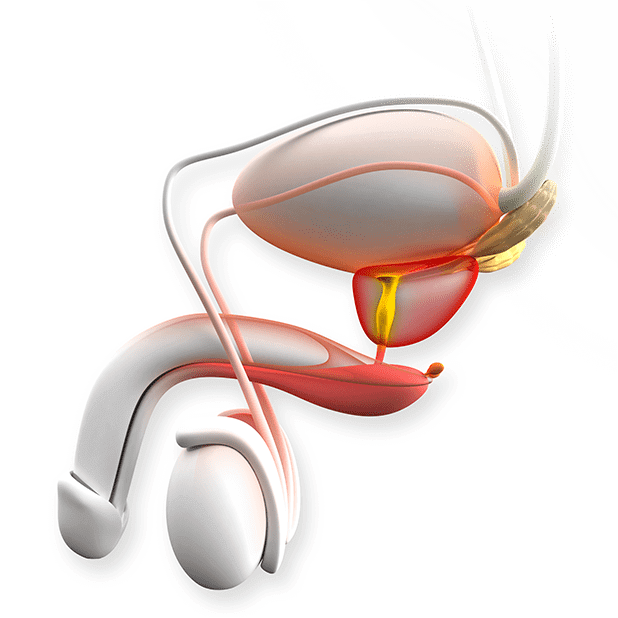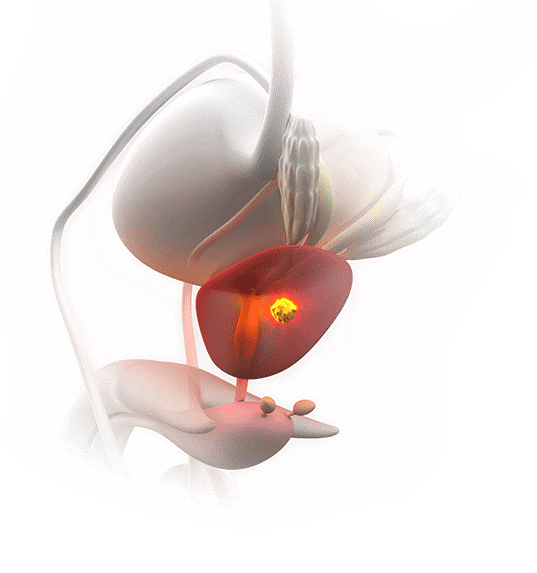
Prostate is located below the urinary bladder, with the rectum at the back and the urethra running through its center. Its location in the immediate vicinity of the urinary tract causes that any pathologic changes affecting the prostate may be associated with problems in urine excretion.
The prostate is similar in shape and size to a chestnut or a walnut and weighs about 11g. In men above 45 years of age it may enlarge to reach the size of a tangerine. A normal prostate without any pathologic changes is smooth and flexible.





1
2
3
4

The prostate (lat.) also referred to as prostatic gland, a part of male reproductive system. It is responsible for the production of secretion which is one of the sperm components.
The prostate is involved in the production of seminal fluid (approx. 15–30% of seminal fluid is supplied by prostate). Seminal fluid nourishes and protects the sperm cells. Testosterone – a hormone produced by the testes – plays a very important role in regulation of prostate’s function.
At birth the prostate’s weight is only a few grams. A physiological growth of the prostate begins during the sexual maturing period in puberty, and by the age of 20 the prostate has reached its adult size and weight. In healthy adult man it has a weight of approx. 11 g and resembles in size and form to a chestnut. A second growth period commences around the 30th to 35th year. It is not yet fully understood what makes prostate to growth. The currently accepted theories consider sexual hormones, androgens and estrogens, to be the driving forces in prostatic growth.

Przed użyciem zapoznaj się z ulotką, która zawiera wskazania, przeciwwskazania, dane dotyczące działań niepożądanych i dawkowanie oraz informacje dotyczące stosowania produktu leczniczego, bądź skonsultuj się z lekarzem lub farmaceutą, gdyż każdy lek niewłaściwie stosowany zagraża Twojemu życiu lub zdrowiu.
Nazwa produktu leczniczego: Prostamol® UNO; 320 mg, kapsułki miękkie Skład jakościowy i ilościowy: Jedna kapsułka zawiera 320 mg wyciągu z owoców palmy sabal (Serenoa repens (W.Bartram) Small (Sabal serrulata (Michaux) Nichols), fructus) (9-11:1).Rozpuszczalnik ekstrakcyjny: alkohol etylowy 96% (V/V).Postać farmaceutyczna: Kapsułki miękkie. Owalne, żelatynowe kapsułki miękkie z nieprzejrzystą, dwukolorową czerwono-czarną otoczką, wypełnione brązowym do żółto- lub zielonkawo-brązowego (oleistym) płynem. Wskazania do stosowania: Produkt roślinny łagodzi objawy związane z rozrostem prostaty występujące przy oddawaniu moczu, jak np.: słaby strumień moczu, parcie na mocz, częstomocz, częste oddawanie moczu w nocy. Przeciwwskazania: Nadwrażliwość na substancję czynną lub którąkolwiek substancję pomocniczą wchodzącą w skład produktu. Podmiot odpowiedzialny posiadający pozwolenie na dopuszczenie do obrotu: BERLIN-CHEMIE AG Glienicker Weg 125 12 489 Berlin Niemcy. Aktualizacja: 01.03.2019. INFORMACJA NAUKOWA: BERLIN-CHEMIE/MENARINI POLSKA Sp. z o.o. ul.Słomińskiego 4, 00-204 Warszawa, tel. 22 566 21 00